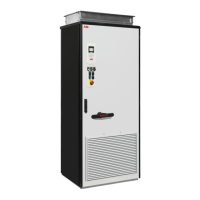Exclusion of liability
ABB is not responsible for the implementation, verification and validation of the overall safety
system. It is the responsibility of the system integrator (or other party) who is responsible
for the overall system and system safety.
The system integrator (or other responsible party) must make sure that the entire
implementation complies with the instructions in this manual, all relevant standards, directives
and local electrical code, and that the system is tested, verified and validated correctly.
Terms and abbreviations
DescriptionTerm
Directives 2014/34/EU and 1999/92/EC are commonly referred to as the ATEX direct-
ives (from "Atmosphères Explosibles")
ATEX
Type of control unitBCU
An IEC term used in the context of explosive atmospheres (IEC 60079)Ex
Type of protection, flameproof enclosures (EN/IEC 60079-1)Ex d
Types of protection, increased safety (EN/IEC 60079-7)Ex eb, Ex ec
Type of protection, intrinsic safety (EN/IEC 60079-11)Ex i
Motors used in explosive atmospheresEx motors
Failure in time: 1E-9 hours (IEC 61508)FIT
Physical size of the drive or power moduleFrame, frame size
Optional pulse encoder interface module for safety encoderFSE-31
Safety functions module which supports the FSE-31 module and the use of safety
encoders
FSO-21
Safety functions module which does not support the use of encodersFSO-12
Hardware fault tolerance (IEC 61508)HFT
Average probability of dangerous failure on demand (IEC 61508)PFD
avg
Programmable logic controllerPLC
Resistance temperature detectorRTD
Safe acceleration rangeSAR
Safe brake controlSBC
Safety integrity level (1...3) (IEC 61508)SIL
Safe stop 1 (IEC/EN 61800-5-2)SS1
Safe stop emergencySSE
Safe torque off (IEC/EN 61800-5-2)STO
There are three categories of stop functions:
• stop category 0: an uncontrolled stop where power to the machine actuators is re-
moved immediately (STO)
• stop category 1: a controlled stop where the machine actuators have power for
stopping, after which the power is removed (SS1)
• stop category 2: a controlled stop where the machine actuators continue to have
power SS2).
Stop category
Proof test interval. Defines the probabilistic failure rate (PFH or PFD
avg
) for the safety
function or subsystem. Performing a proof test at a maximum interval of T
1
is required
to keep the SIL capability valid. The same interval must be followed to keep the PL
capability (EN ISO 13849) valid. Note that any T
1
values given cannot be regarded
as a guarantee or warranty.
T
1
Type of control unitZCU
Potentially explosive atmosphere. Hazardous areas are divided into zones, based on
the frequency and duration of the occurrence of an explosive atmosphere. (EN/IEC
60079)
Zone
14 Introduction to the manual

